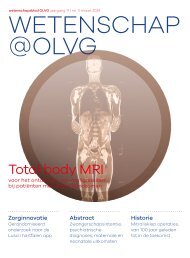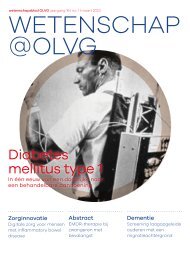Escaping the Scalpel
In-depth evidence to change clinical practice for patients with a degenerative meniscal tear. By Julia C.A. Noorduyn
In-depth evidence to change clinical practice for patients with a degenerative meniscal tear.
By Julia C.A. Noorduyn
Create successful ePaper yourself
Turn your PDF publications into a flip-book with our unique Google optimized e-Paper software.
32<br />
CHAPTER II<br />
ness among 100 patients with meniscal injuries, and Irrgang et al. [11] analyzed <strong>the</strong> responsiveness<br />
of 207 patients with a variety of knee disorders. Both studies concluded adequate<br />
responsiveness, using <strong>the</strong> effect size without predefined hypo<strong>the</strong>sis as a measure of responsiveness.<br />
This is considered a less suitable method, since it measures magnitude of change<br />
ra<strong>the</strong>r than quality of <strong>the</strong> measurement.[1, 5] Our results confirm that <strong>the</strong> IKDC is responsive<br />
to change based on recommended methodology.[18]<br />
Strengths and Limitations<br />
To our knowledge, this is <strong>the</strong> first study that determined <strong>the</strong> responsiveness and MIC of <strong>the</strong><br />
IKDC among patients 45 to 70 years old with symptomatic meniscal tears, using predefined<br />
hypo<strong>the</strong>ses with <strong>the</strong> expected magnitude and direction of <strong>the</strong> correlations. While previous<br />
studies investigating responsiveness with hypo<strong>the</strong>ses testing used a general cutoff criterion<br />
of 0.5 for <strong>the</strong> expected correlations,[22, 29, 30] we defined more specific criteria to enhance<br />
<strong>the</strong> quality of our hypo<strong>the</strong>ses. Ano<strong>the</strong>r strength is that we utilized a large sample (n = 298)<br />
with >90% complete data. Third, with a relatively short interval (6 months), we are confident<br />
that patients could adequately recall any changes in physical functioning and that <strong>the</strong>se<br />
changes were largely related to <strong>the</strong> treatment that <strong>the</strong>y received. Fourth, we used <strong>the</strong> anchorbased<br />
MIC distribution for <strong>the</strong> calculation of <strong>the</strong> MIC to give more insight into <strong>the</strong> interpretation<br />
of <strong>the</strong> MIC. There were also limitations to this study. First, <strong>the</strong> data were retrieved from<br />
a randomized controlled trial, which could have led to selection bias. Second, <strong>the</strong> anchor<br />
question was not a true reflection of <strong>the</strong> construct measured by <strong>the</strong> IKDC. The anchor question<br />
focused on functioning in daily living, and <strong>the</strong> IKDC measures knee-specific symptoms,<br />
functioning, and activities. However, we found a strong correlation (r = 0.64) between <strong>the</strong><br />
anchor question and change in IKDC score. The results of our study apply specifically to patients<br />
45 to 70 years old with degenerative meniscal tears and can be different for patients<br />
with traumatic meniscal tears or o<strong>the</strong>r knee pathologies.<br />
Implications of <strong>the</strong> Study<br />
The results of this study contribute to <strong>the</strong> evidence regarding <strong>the</strong> measurement properties<br />
of <strong>the</strong> IKDC among patients with meniscal tears; <strong>the</strong> IKDC is also responsive to change in<br />
this population and is valid and reliable. An MIC of 10.9 was established, which streng<strong>the</strong>ned<br />
<strong>the</strong> value of <strong>the</strong> IKDC for assessing patient-reported knee function. The MIC of 10.9<br />
points was determined on a group level. These results can <strong>the</strong>refore be used on a group level,<br />
whe<strong>the</strong>r by policy makers to determine treatment per recipient or by researchers to compare<br />
different treatments.[4, 6, 7] The distinctive character of <strong>the</strong> MIC between ‘‘changed’’ and<br />
‘‘unchanged,’’ on a group level, makes it highly relevant for developing clinical prediction<br />
models. Fur<strong>the</strong>rmore, based on <strong>the</strong> sensitivity and specificity levels (79.7% and 72.9%, respectively)<br />
and <strong>the</strong> probability of <strong>the</strong> measurement error (2%), <strong>the</strong> MIC of 10.9 can also be<br />
applied to individual patients. [4, 6, 7]However, one should take <strong>the</strong> patient’s characteristics<br />
into account when applying <strong>the</strong> MIC on an individual level.[20]
















